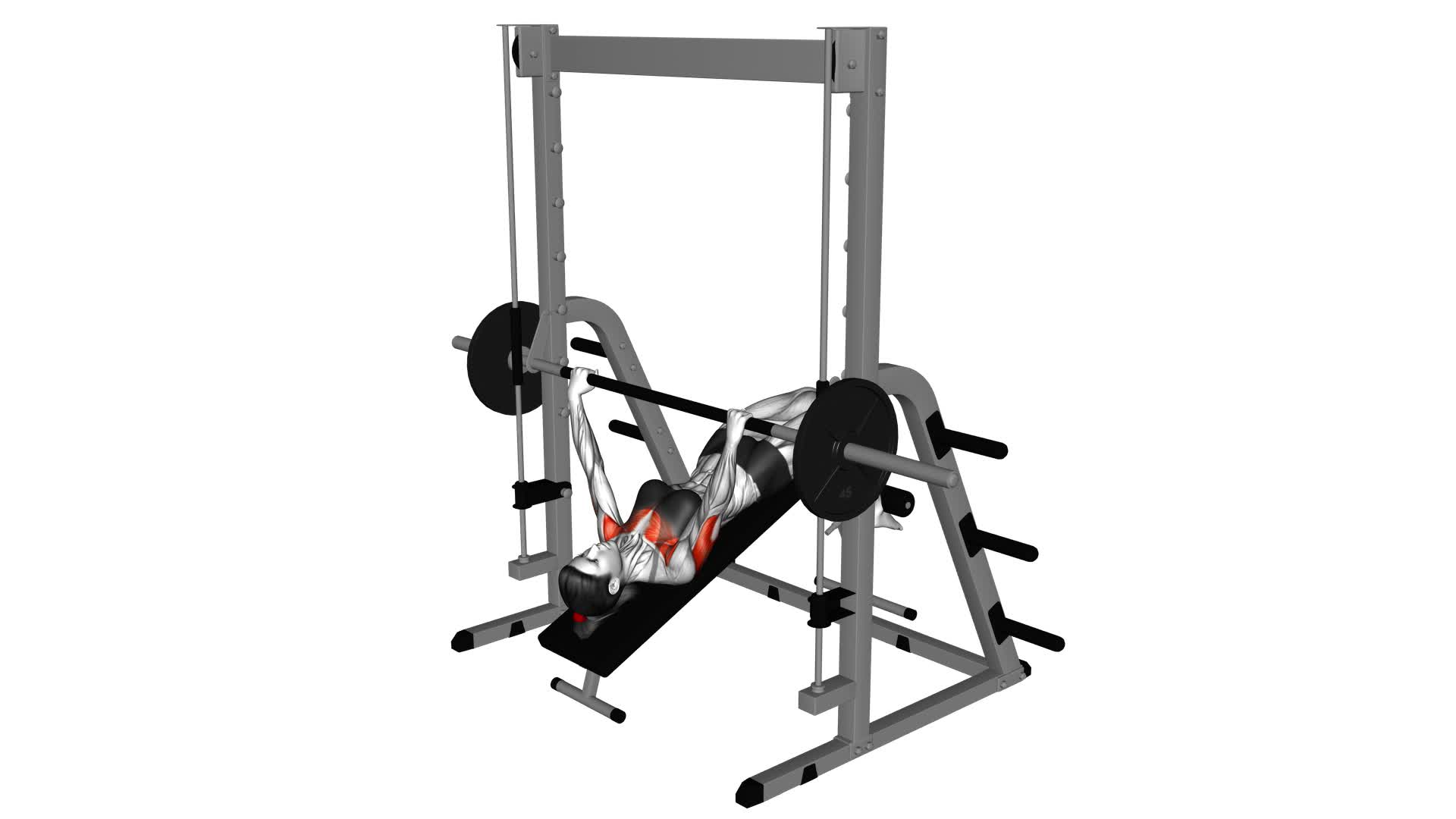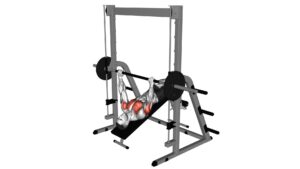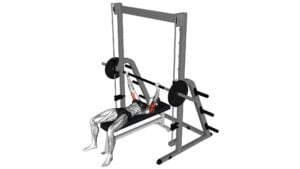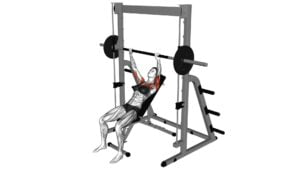Smith Decline Bench Press (female) – Video Exercise Guide & Tips

Looking to amp up your upper body workout?
Watch This Exercise Video
Check out this video exercise guide and tips on the Smith Decline Bench Press.
This exercise is great for targeting your chest muscles and can be modified to fit different fitness levels.
Avoid common mistakes and maximize the effectiveness of your workout with these helpful tips.
Get ready to feel the burn and achieve your fitness goals with the Smith Decline Bench Press!
Key Takeaways
- Targets and strengthens lower chest muscles
- Engages triceps and shoulders to a lesser extent
- Provides variation and challenges for lower chest muscles
- Helps build strength and definition in the lower chest area
Benefits of the Smith Decline Bench Press
One benefit of the Smith Decline Bench Press is its ability to target and strengthen your lower chest muscles. The Smith Decline Bench Press is a variation of the traditional decline bench press exercise, which involves lying on a decline bench and pushing a barbell or dumbbells upwards. However, the Smith Decline Bench Press offers unique advantages and can be an effective alternative to the traditional exercise.
While the traditional decline bench press primarily targets the lower chest muscles, the Smith Decline Bench Press also engages the triceps and shoulders to a lesser extent. This variation allows you to isolate and focus on your lower chest muscles, helping to build strength and definition in that area.
If you're looking for alternatives to the Smith Decline Bench Press, there are several exercises that can target your lower chest muscles. These include the decline dumbbell press, decline push-ups, and the decline cable fly. Incorporating these exercises into your workout routine can provide variation and help you continue to challenge your lower chest muscles.
Now that you understand the benefits and alternatives of the Smith Decline Bench Press, it's important to learn the proper form and technique for the exercise. By maintaining proper form, you can maximize the effectiveness of the exercise and minimize the risk of injury.
Proper Form and Technique for the Exercise
To perform the Smith Decline Bench Press with proper form and technique, there are a few common mistakes you should avoid.
First, make sure to keep your back flat against the bench throughout the exercise, as arching can lead to strain or injury.
Secondly, maintain control and avoid bouncing the bar off your chest, as this can put unnecessary stress on your shoulders.
Common Mistakes to Avoid
Avoid these common mistakes when performing the Smith Decline Bench Press exercise to ensure proper form and technique.
- Improper Breathing: One common mistake isn't breathing correctly during the exercise. Remember to inhale as you lower the barbell towards your chest and exhale as you push it back up. This will help stabilize your core and maximize your strength.
- Incorrect Foot Placement: Another mistake is placing your feet in the wrong position. Make sure your feet are firmly planted on the ground, shoulder-width apart. This will provide a stable base and allow for proper leg drive during the movement.
- Arching Your Back: Avoid arching your back excessively as you press the weight. This can lead to lower back strain and injury. Keep your back flat against the bench and engage your core throughout the exercise.
- Using Too Much Weight: Lastly, using too much weight can compromise your form and increase the risk of injury. Start with a weight that allows you to maintain proper form and gradually increase as you become stronger. Focus on quality repetitions rather than pushing for maximum weight.
Benefits of Proper Technique
Maximize your strength and minimize the risk of injury by implementing proper form and technique for the Smith Decline Bench Press exercise.
Proper technique offers numerous benefits that can enhance your workout experience and help you achieve your fitness goals more effectively.
Firstly, using proper form ensures that you're targeting the correct muscles and maximizing their engagement during the exercise. This leads to improved muscle activation and development.
Secondly, proper technique promotes proper joint alignment, reducing the risk of strain or injury. By maintaining a stable position and controlling the movement throughout the exercise, you can protect your joints and prevent unnecessary stress.
Lastly, proper technique allows for better control and stability, leading to increased strength gains over time. By performing the Smith Decline Bench Press with proper form, you can optimize your results and minimize the risk of setbacks.
Variations and Modifications for Different Fitness Levels
Customize the Smith Decline Bench Press to suit your fitness level and goals. Here are some variations and modifications you can try based on your experience and athleticism:
- Variations for beginners:
- Start with a lighter weight or no weight at all to focus on perfecting your form and building strength gradually.
- Use a stability ball instead of a bench to engage your core and challenge your balance.
- Perform the exercise with dumbbells instead of a barbell to improve stability and control.
- Modifications for advanced athletes:
- Increase the weight gradually to continue challenging your muscles and promoting growth.
- Add a pause at the bottom of the movement to intensify the muscle contraction.
- Use resistance bands to increase the difficulty and engage more muscle fibers.
- Incorporate explosive movements, such as plyometric push-ups, to enhance power and explosiveness.
By customizing the Smith Decline Bench Press to your fitness level, you can ensure that you're working at the appropriate intensity for your goals.
Now let's move on to the next section and learn about common mistakes to avoid while performing the exercise.
Common Mistakes to Avoid While Performing the Exercise
When performing the Smith decline bench press, it's important to avoid common mistakes that can hinder your progress and increase the risk of injury.
One common mistake is incorrect grip positioning, which can put unnecessary strain on your wrists and limit your ability to perform the exercise effectively.
Another mistake is lacking proper form, such as arching your back or bouncing the weight off your chest, which can compromise the effectiveness of the exercise and increase the risk of strain or injury.
Finally, overloading the weight is a mistake that can lead to poor form and increase the risk of muscle imbalances or injury.
Incorrect Grip Positioning
To avoid making a common mistake while performing the Smith Decline Bench Press (female), ensure your grip positioning is correct. Incorrect hand placement can lead to potential injuries, so it's essential to pay attention to how you hold the bar. Here are four key points to keep in mind:
- Place your hands slightly wider than shoulder-width apart on the bar.
- Make sure your palms are facing forward and your fingers are wrapped firmly around the bar.
- Avoid gripping the bar too tightly, as this can strain your wrists and forearms.
- Keep your thumbs wrapped around the bar to maintain a secure grip and prevent the bar from slipping.
Lack of Proper Form
Maintain proper form to avoid common mistakes while performing the Smith Decline Bench Press (female).
Improper technique can lead to injuries, so it's important to pay attention to your form during this exercise. One common mistake to avoid is arching your back excessively. This puts unnecessary strain on your lower back and increases the risk of injury. Instead, focus on keeping your back flat against the bench throughout the movement.
Another mistake to watch out for is flaring your elbows out to the sides. This can strain your shoulders and decrease the effectiveness of the exercise. Keep your elbows tucked in close to your body to maintain proper alignment.
By maintaining proper form, you can prevent injuries and maximize the benefits of the Smith Decline Bench Press (female).
Now let's move on to the next topic: overloading the weight.
Overloading the Weight
To avoid overloading the weight and making common mistakes while performing the Smith Decline Bench Press (female), ensure that you're using an appropriate amount of weight for your current strength level. Overloading the weight can lead to poor form and increase the risk of injury.
Here are some tips to prevent overloading and promote proper technique for injury prevention:
- Start with a weight that allows you to perform the exercise with correct form.
- Gradually increase the weight as your strength improves.
- Avoid using momentum or bouncing the weight off your chest.
- Listen to your body and stop if you experience any pain or discomfort.
Tips for Maximizing the Effectiveness of the Smith Decline Bench Press
Get the most out of your Smith Decline Bench Press by focusing on proper form and engaging your muscles throughout the entire range of motion. To maximize your results, it's crucial to pay attention to your breathing technique. Proper breathing during the Smith Decline Bench Press can help you maintain stability and maximize the effectiveness of the exercise.
When performing the Smith Decline Bench Press, inhale deeply before lowering the barbell towards your chest. As you lower the weight, exhale forcefully, keeping your core tight and engaging your abdominal muscles. This exhale should be done in a controlled manner, helping you generate more power and stability during the pressing phase.
It is also important to maintain a steady rhythm and pace throughout the exercise. Avoid holding your breath or taking shallow breaths, as this can limit your performance and reduce the effectiveness of the exercise. Remember to breathe consistently and rhythmically throughout each repetition.
Furthermore, focusing on proper form and technique is crucial for maximizing the effectiveness of the Smith Decline Bench Press. Ensure that your feet are firmly planted on the ground, your back is in contact with the bench, and your grip is secure on the barbell. Engage your chest, shoulders, and triceps as you press the weight up, and lower it in a controlled manner to fully engage your muscles.
Sample Workout Routine Incorporating the Smith Decline Bench Press
To effectively incorporate the Smith Decline Bench Press into your workout routine, start by including compound exercises that target multiple muscle groups. This will help you warm up your body and prepare it for the intensity of the bench press.
Here is a sample workout routine that incorporates the Smith Decline Bench Press:
- Warm-up: Begin with 5-10 minutes of light cardio to get your blood flowing and muscles warm.
- Compound Exercise: Start with a set of squats to engage your lower body and core muscles.
- Upper Body Exercise: Follow the squats with a set of barbell rows or pull-ups to work your back and biceps.
- Smith Decline Bench Press: Perform 3-4 sets of the Smith Decline Bench Press, focusing on maintaining proper form and range of motion. Remember to adjust the bench to a decline position for optimal muscle activation.
- Chest Isolation Exercise: Finish your workout with a chest isolation exercise such as dumbbell flyes or cable crossovers to target the pectoral muscles.
Frequently Asked Questions
How Many Calories Can You Burn While Performing the Smith Decline Bench Press?
When performing the Smith Decline Bench Press, you can burn a significant amount of calories. This exercise engages multiple muscle groups, including your chest, shoulders, and triceps, resulting in an increased calorie burn.
However, the exact number of calories burned will vary depending on factors such as your weight, intensity, and duration of the workout.
It's important to note that performing this exercise with a spotter is recommended to ensure safety and proper form.
Can the Smith Decline Bench Press Help in Reducing Belly Fat?
The Smith Decline Bench Press can certainly help in reducing belly fat. It's a great exercise that targets the lower abs and obliques, which are common problem areas for many people.
However, it's important to note that no single exercise can specifically target belly fat. To effectively reduce belly fat, it's crucial to combine the Smith Decline Bench Press with other exercises that engage the entire body, and also maintain a healthy diet that supports fat loss.
Are There Any Specific Muscle Groups Targeted by the Smith Decline Bench Press?
When it comes to the Smith Decline Bench Press, there are specific muscle groups that it targets. This exercise primarily works your chest muscles, specifically the lower part. Additionally, it also engages your triceps, shoulders, and core.
The decline angle of the bench puts more emphasis on the lower chest, making it a great variation to incorporate into your workout routine. By targeting these muscle groups, the Smith Decline Bench Press can help you build strength and definition in these areas.
Can the Smith Decline Bench Press Be Done Without a Spotter?
Yes, you can do the Smith Decline Bench Press without a spotter. However, it's always recommended to have a spotter for safety purposes, especially when lifting heavy weights.
The Smith Decline Bench Press is a great exercise to increase strength, as it targets the chest, shoulders, and triceps.
If you don't have a spotter, you can try alternative exercises like the dumbbell decline bench press or the push-up.
Remember to start with lighter weights and gradually increase as you get comfortable and confident.
Is It Necessary to Warm up Before Performing the Smith Decline Bench Press?
Before performing the smith decline bench press, it's necessary to warm up your muscles. This will help increase blood flow, prevent injuries, and improve your performance.
Incorporating this exercise into your workout routine has many benefits, including targeting your lower chest muscles and building upper body strength.
To ensure proper form and technique, make sure to keep your feet firmly planted on the ground, maintain a controlled and steady movement, and avoid arching your back.
Conclusion
In conclusion, the Smith decline bench press is a highly effective exercise for targeting the lower chest muscles. By using proper form and technique, individuals can maximize the benefits of this exercise.
It's important to remember variations and modifications to accommodate different fitness levels and avoid common mistakes.
By incorporating the Smith decline bench press into a regular workout routine, individuals can achieve a stronger and more defined chest.

Author
Years ago, the spark of my life’s passion ignited in my mind the moment I stepped into the local gym for the first time. The inaugural bead of perspiration, the initial endeavor, the very first surge of endorphins, and a sense of pride that washed over me post-workout marked the beginning of my deep-seated interest in strength sports, fitness, and sports nutrition. This very curiosity blossomed rapidly into a profound fascination, propelling me to earn a Master’s degree in Physical Education from the Academy of Physical Education in Krakow, followed by a Sports Manager diploma from the Jagiellonian University. My journey of growth led me to gain more specialized qualifications, such as being a certified personal trainer with a focus on sports dietetics, a lifeguard, and an instructor for wellness and corrective gymnastics. Theoretical knowledge paired seamlessly with practical experience, reinforcing my belief that the transformation of individuals under my guidance was also a reflection of my personal growth. This belief holds true even today. Each day, I strive to push the boundaries and explore new realms. These realms gently elevate me to greater heights. The unique combination of passion for my field and the continuous quest for growth fuels my drive to break new ground.







